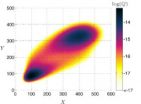(Press-News.org) WASHINGTON D.C. May 6, 2013 -- The eye is an exquisitely sensitive system with many aspects that remain somewhat of a mystery—both in the laboratory and in the clinic.
A U.S.-based team of mathematicians and optometrists is working to change this by gaining a better understanding of the inner workings of tear film distribution over the eye's surface. This, in turn, may lead to better treatments or a cure for the tear film disease known as "dry eye." They describe their work in the journal Physics of Fluids.
Dry eye disease afflicts millions of people worldwide, with symptoms such as pain, dryness, redness, reduced visual acuity, and feelings of grittiness. While drops can provide some temporary relief, dry eye conditions can damage the cornea and, over time, result in reduced visual function.
When the tear film functions properly, a thin liquid film coats the eye surface during a blink by the upper eyelid, creating a smooth optical surface for vision and allowing us to see clearly.
"With dry eye, this optical function is disrupted by either insufficient tear volume or by excessively rapid evaporation of water from the tear film," explains Richard Braun, a professor in the University of Delaware's Department of Mathematical Sciences. "In either case, the tear film may not be able to form a smooth optical interface for a sufficiently long time to allow normal eye function."
The tear film on the surface of the eye is a very thin fluid layer—only a few millionths of a meter thick. This thickness is less than 1,000 times the size of the eye opening, which is approximately 1 centimeter.
Braun and colleagues "took advantage of this difference in sizes to develop simplified mathematical models that work quite well to capture experimentally observed phenomena in vivo," he said.
Once the team created a mathematical model, they were able to solve it using numerical methods in the computer appropriate for solving the equations on irregularly shaped domains like the shape of the exposed area of the eye. "We use and extend a computational framework called 'Overture,' which was originally developed at Lawrence Livermore National Laboratory," Braun added.
Under the assumptions of their model, the team quantified the dynamics all over the exposed ocular surface, and the results agreed well with in vivo observations of the tear film gained from fluorescence imaging. "Our mathematical results captured how tear fluid makes its way around the eyelids to the drainage holes called 'puncta,' in the inside corner of the eye," he said.
Among the team's key findings was verifying that it takes "a blink" to redistribute tear film. "The evaporated tear film on the front of the eye can't be replenished by simply supplying more new tear fluid from the lacrimal gland," Braun noted.
Braun believes their results "may aid in the development of better treatments for dry eye, and also add valuable context and understanding for current imaging techniques used to observe tear film dynamics."
INFORMATION:
The article, "Tear Film Dynamics with Evaporation, Wetting, and Time-Dependent Flux Boundary Condition on an Eye-Shaped Domain" is authored by Longfei Li, Richard J. Braun, Kara L. Maki, William Henshaw, and P.E. King-Smith. It will be published in the journal Physics of Fluids on May 6, 2014 (DOI: 10.1063/1.4871714). After that date, it can be accessed at: http://scitation.aip.org/content/aip/journal/pof2/26/5/10.1063/1.4871714
In addition to the University of Delaware, researchers on this paper are affiliated with Rochester IT, Lawrence Livermore National Laboratory and The Ohio State University.
ABOUT THE JOURNAL
Physics of Fluids is devoted to the publication of original theoretical, computational, and experimental contributions to the dynamics of gases, liquids, and complex or multiphase fluids. See: http://pof.aip.org
Working to cure 'dry eye' disease
Seeking better understanding of the eye's tear film distribution, scientists are also looking for better treatments and cure for disease that afflicts millions
2014-05-06
ELSE PRESS RELEASES FROM THIS DATE:
Predator-prey made simple
2014-05-06
WASHINGTON D.C. May 6, 2013 -- A team of U.K. researchers has developed a way to dramatically reduce the complexity of modeling "bistable" systems which involve the interaction of two evolving species where one changes faster than the other ("slow-fast systems"). Described in The Journal of Chemical Physics, the work paves the way for easier computational simulations and predictions involving such systems, which are found in fields as diverse as chemistry, biology and ecology.
Imagine, for instance, trying to predict how a population of whales would fare based on the ...
A cup of coffee a day may keep retinal damage away
2014-05-06
ITHACA, N.Y. – Coffee drinkers, rejoice! Aside from java's energy jolt, food scientists say you may reap another health benefit from a daily cup of joe: prevention of deteriorating eyesight and possible blindness from retinal degeneration due to glaucoma, aging and diabetes.
Raw coffee is, on average, just 1 percent caffeine, but it contains 7 to 9 percent chlorogenic acid, a strong antioxidant that prevents retinal degeneration in mice, according to a Cornell study published in the Journal of Agricultural and Food Chemistry.
The retina is a thin tissue layer on the ...
Expert guidance strengthens strategies to prevent most common and costly infection
2014-05-06
CHICAGO (May 6, 2014) – Surgical site infections (SSIs) are the most common and costly healthcare-associated infection (HAI) in the United States. New evidence-based recommendations provide a framework for healthcare institutions to prioritize and implement strategies to reduce the number of infections.
The guidelines are published in the June issue of Infection Control and Hospital Epidemiology and were produced in a collaborative effort led by the Society for Healthcare Epidemiology of America, the Infectious Diseases Society of America, the American Hospital Association, ...
New expert guidelines aim to focus hospitals' infectious diarrhea prevention efforts
2014-05-06
CHICAGO (May 6, 2014) – With rates of Clostridium difficile (C. difficile) now rivaling drug-resistant Methicillin-resistant Staphylococcus aureus (MRSA) as the most common bacteria to cause healthcare-associated infections, new expert guidance encourages healthcare institutions to implement and prioritize prevention efforts for this infectious diarrhea. The guidelines are published in the June issue of Infection Control and Hospital Epidemiology.
The new practice recommendations are a part of Compendium of Strategies to Prevent Healthcare-Associated Infections in Acute ...
As kids age, snacking quality appears to decline
2014-05-06
PROVIDENCE, R.I. [Brown University] — The average U.S. child snacks three times a day. Concerned about the role of snacking in obesity, a team of researchers set out to explore how eating frequency relates to energy intake and diet quality in a sample of low-income, urban schoolchildren in the Boston area. They expected that snacking would substantially contribute to kids' overall energy intake, and the new data confirm that. But they were surprised that the nutritional value of snacks and meals differed by age.
The findings, led by first author E. Whitney Evans, a ...
Planck reveals magnetic fingerprint of our galaxy
2014-05-06
The team—which includes researchers from the University of British Columbia and the Canadian Institute for Theoretical Astrophysics (CITA) at the University of Toronto—created the map using data from the Planck Space Telescope. Since 2009, Planck has charted the Cosmic Microwave Background (CMB), the light from the Universe a mere 380,000 years after the Big Bang.
But Planck also observes light from much closer than the farthest reaches of time and space. With an instrument called the High Frequency Instrument (HFI), Planck detects the light from microscopic dust particles ...
GW researcher discovers the mechanisms that link brain alertness and increased heart rate
2014-05-06
WASHINGTON (May 6, 2014) — George Washington University (GW) researcher David Mendelowitz, Ph.D., was recently published in the Journal of Neuroscience for his research on how heart rate increases in response to alertness in the brain. Specifically, Mendelowitz looked at the interactions between neurons that fire upon increased attention and anxiety and neurons that control heart rate to discover the "why," "how," and "where to next" behind this phenomenon.
"This study examines how changes in alertness and focus increase your heart rate," said Mendelowitz, vice chair ...
Scientists identify new protein in the neurological disorder dystonia
2014-05-06
MANHATTAN, Kan. — A collaborative discovery involving Kansas State University researchers may lead to the first universal treatment for dystonia, a neurological disorder that affects nearly half a million Americans.
Michal Zolkiewski, associate professor of biochemistry and molecular biophysics at Kansas State University, and Jeffrey Brodsky at the University at Pittsburgh co-led a study that focused on a mutated protein associated with early onset torsion dystonia, or EOTD, the most severe type of dystonia that typically affects adolescents before the age of 20. Dystonia ...
International team maps nearly 200,000 global glaciers in quest for sea rise answers
2014-05-06
An international team led by glaciologists from the University of Colorado Boulder and Trent University in Ontario, Canada has completed the first mapping of virtually all of the world's glaciers -- including their locations and sizes -- allowing for calculations of their volumes and ongoing contributions to global sea rise as the world warms.
The team mapped and catalogued some 198,000 glaciers around the world as part of the massive Randolph Glacier Inventory, or RGI, to better understand rising seas over the coming decades as anthropogenic greenhouse gases heat the ...
GW researcher looks 'inside the box' for a sustainable solution for intestinal parasites
2014-05-06
WASHINGTON (May 6, 2014) — According to the World Health Organization, more than 450 million people worldwide, primarily children and pregnant women, suffer illness from soil-transmitted helminths (STH), intestinal parasites that live in humans and other animals. Considerable effort and resources have been, and continue to be, spent on top-down, medical-based programs focused on administering drugs to control STH infections, with little success. John Hawdon, Ph.D., associate professor of microbiology, immunology, and tropical medicine at the George Washington University ...
LAST 30 PRESS RELEASES:
Climate extremes triggered rare coral disease and mass mortality on the Great Barrier Reef
Direct observation reveals “two-in-one” roles of plasma turbulence
Humans rank between meerkats and beavers in monogamy ‘league table’
US fossil reveals early mass-burial event and ancient microbial attack
Sedative choice could improve outcomes for breathing tube patients
New superconducting thin film for quantum computer chips
Simulations reveal protein "dynamin" constricts cell membranes by loosening its grip
Nearly 1 in 5 UK emergency department patients cared for in corridors/waiting rooms
Heavy energy drink intake may pose serious stroke risk, doctors warn
Violence against women and children among top health threats: New global study reveals disease burden far larger than previously estimated
Predicting who is at risk of developing type 1 diabetes, as new drugs now available
New gene-mapping method unlocks hidden drivers of cancer
Ocean current and seabed shape influence warm water circulation under ice shelves
Call to increase funding for ‘invisible’ Deaf victim-survivors of domestic abuse
University of Maryland School of Medicine names distinguished scientist and academic leader Gerald M. Wilson, PhD, as Chair of the Department of Biochemistry and Molecular Biology
Receptors in mammary glands make livestock and humans inviting hosts for avian flu
Icy hot plasmas
Treating adults with autism: Maryland Clinical Center offers national blueprint for care after pediatric transition
University of Phoenix College of Doctoral Studies releases white paper on reclaiming control to build workforce resilience
NCCN Summit seeks to improve care for veterans and first responders with cancer from line-of-duty exposure
ERC Consolidator Grant for soft robotics researcher
Dual-action arts and wellbeing program transforms dementia care
The global plastic waste trade contributes to coastal litter in importing countries, study shows
UT Dallas partners with Tech Mahindra on AI innovation
Blinking less could signal the brain is working harder to listen, Concordia study shows
Male bonobos track females’ reproductive cycle to maximize mating success
New report outlines science priorities for human Mars exploration
Want to curb cannabis-related crashes? Don’t forget older adults, study finds
Expectant management vs medication for patent ductus arteriosus in preterm infants
Pew funds 7 new biomedical research collaborations
[Press-News.org] Working to cure 'dry eye' diseaseSeeking better understanding of the eye's tear film distribution, scientists are also looking for better treatments and cure for disease that afflicts millions


